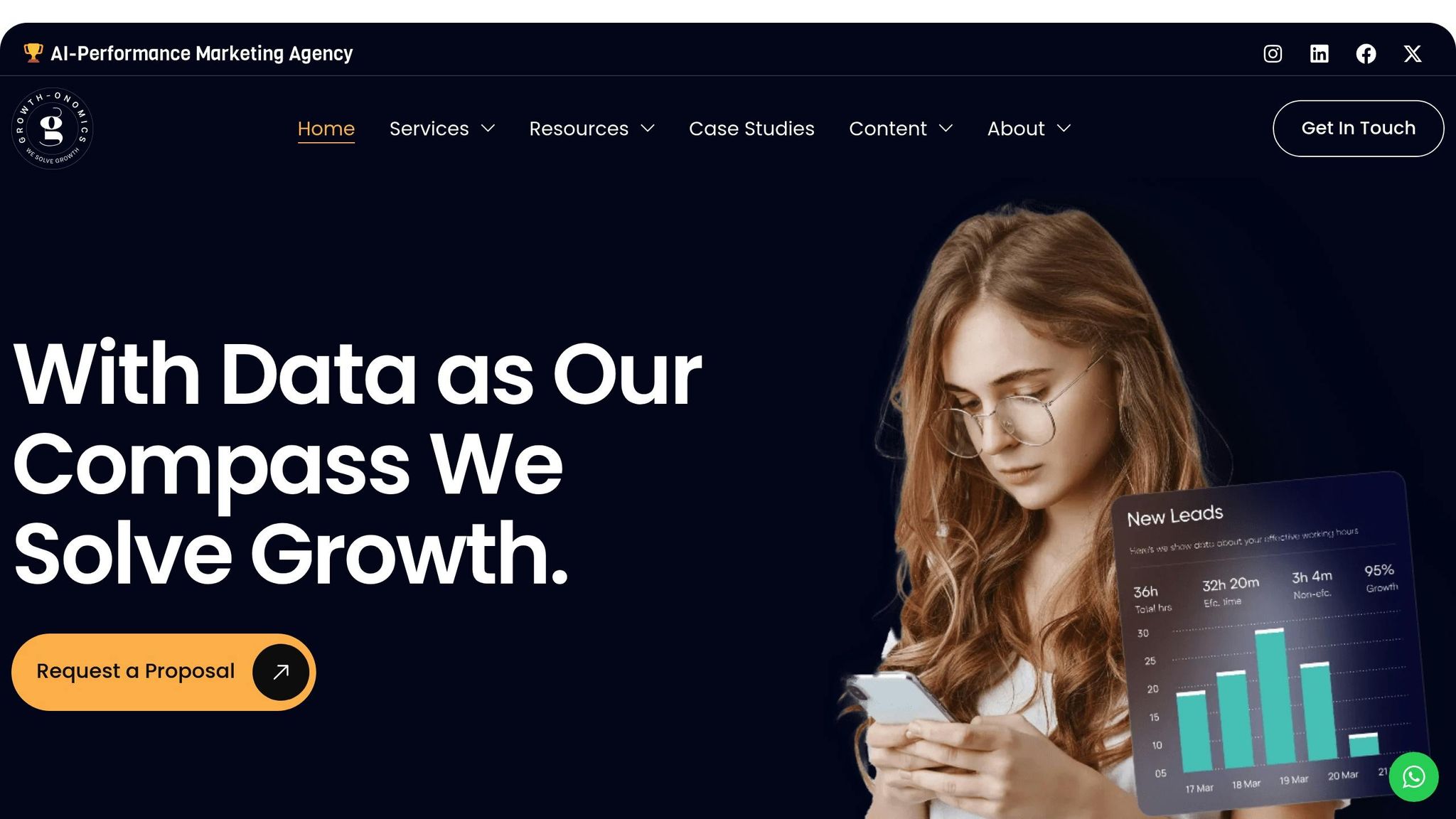What’s the difference between cross-channel and channel-specific optimization? It’s all about how you approach marketing efforts.
- Channel-specific optimization focuses on improving one platform at a time (e.g., perfecting Instagram ads or email campaigns). It’s simpler, less resource-intensive, and ideal for startups, limited budgets, or specialized audiences.
- Cross-channel optimization connects multiple platforms to create a smooth customer journey (e.g., combining Instagram ads, email, and retargeting). It’s better suited for businesses aiming to increase customer retention, lifetime value, or handle complex sales cycles.
Key Stats:
- Brands with strong cross-channel strategies see a 9.5% annual revenue increase compared to 3.4% for weaker strategies.
- 95% of customers use multiple channels when making purchase decisions.
- Companies excelling in cross-channel marketing retain 89% of their customers, compared to 33% for others.
The choice depends on your goals, resources, and audience behavior. Smaller businesses often start with channel-specific efforts, while larger ones benefit from cross-channel strategies. Sometimes, a mixed approach works best.
How to Create A Cross-Channel Marketing Strategy
Channel-Specific Optimization Explained
Channel-specific optimization zeroes in on improving performance within a single marketing channel at a time. Instead of juggling multiple platforms, this strategy focuses on becoming an expert in one channel, maximizing its potential before moving on to others. Think of it as diving deep into one pool rather than skimming the surface of many.
The idea is simple: prioritize depth over breadth. For example, rather than running campaigns across Facebook, Google Ads, email, and LinkedIn all at once, you might start by perfecting your Facebook ads. This means learning how Facebook’s algorithm works, figuring out the best ad formats, identifying peak activity times, and creating content that aligns with the platform’s engagement patterns.
Let’s break down the key features of this approach and when it’s most effective.
Main Features of Channel-Specific Optimization
When focusing on a single platform, several tactics become essential to success:
- A/B Testing: This is the backbone of channel-specific optimization. By testing different versions of ads, emails, or posts, you can see what resonates most with your audience on that platform.
- Refined Audience Segmentation: Instead of broad customer personas, this approach digs into platform-specific behaviors. For instance, email subscribers might be segmented by how often they open emails, while social media followers could be grouped by interaction type – likes, shares, or comments.
- Tailored Creative Content: Each platform has its own style and preferences. What works on LinkedIn’s professional network might fall flat on TikTok. With channel-specific optimization, content is customized to fit the platform’s format, length, and visual style.
- Platform-Specific Metrics: Success is measured differently depending on the channel. For email, you track open rates and click-through rates. On social media, it’s about impressions, engagement rates, and follower growth. Google Ads focuses on metrics like cost-per-click and conversion rates.
- Behavioral Analysis: Understanding how your audience interacts with content is crucial. This includes studying peak engagement times, identifying high-performing content types, and analyzing which calls-to-action drive the most conversions.
By tailoring your strategy to a single platform, you can fine-tune your efforts and get the most out of your marketing investment.
Best Times to Use Channel-Specific Optimization
This approach shines in specific scenarios, making it a go-to strategy under certain conditions:
- When One Channel Outshines the Rest: If a single platform is consistently driving most of your leads or sales, focusing on it can deliver better results than spreading resources thin across multiple channels.
- Limited Budgets: For startups or small businesses, it’s often smarter to master one channel first. This ensures a higher return on investment before expanding to other platforms.
- New Product Launches or Testing: When introducing a new product or service, concentrating on one channel provides clear performance data, helping you understand what resonates with your audience.
- Specialized Audiences: Some audiences gravitate toward specific platforms. For example, LinkedIn is ideal for B2B decision-makers, while Instagram works better for fashion brands. Channel-specific optimization helps you connect with your audience where they’re most active.
- Seasonal Campaigns: If you’re running a time-sensitive promotion, focusing on the platform with the highest conversion rates can maximize your impact.
- Troubleshooting Underperforming Campaigns: When a particular platform isn’t delivering results, dedicating time to understand its nuances can turn things around more effectively than trying to optimize multiple channels at once.
Cross-Channel Optimization Explained
Cross-channel optimization is all about creating a seamless, unified customer experience across multiple platforms. Think of it like an orchestra – each instrument (or channel) plays its part, but together, they create a harmonious performance. According to industry insights, this strategy involves redistributing media budgets across various marketing channels to maximize overall impact while keeping the entire customer journey in focus.
This approach connects every touchpoint, ensuring data is shared, messages are aligned, and interactions are well-timed. For example, a customer might first see your brand on Instagram, then search for your products on Google, subscribe to your newsletter, and finally make a purchase after seeing a retargeting ad. Instead of working in silos, cross-channel strategies prioritize consistent messaging and timing, guiding customers through a smooth, interconnected journey. This method not only enhances the customer experience but also sets the stage for the key components we’ll explore next.
The benefits of cross-channel optimization are clear: it boosts customer retention. Companies that excel in cross-channel marketing retain 89% of their customers on average, compared to just 33% for those with poor engagement.
Core Components of Cross-Channel Optimization
For cross-channel optimization to succeed, several key elements must work together:
- Unified Data Flow: Breaking down barriers between platforms lets data move freely. For instance, a display ad might trigger a personalized email sequence. In November 2024, StackAdapt highlighted a software company that used display ads to target decision-makers. This led prospects to download a gated whitepaper, after which their CRM and marketing automation tools sent personalized emails with case studies and demo offers.
- Consistent Messaging and Timing: A strong, unified brand presence across channels is essential. While the core message stays the same, its format adapts to fit each platform’s strengths. This ensures a smooth transition for customers as they move between channels, creating a cohesive experience.
- Dynamic Budget Allocation: Instead of sticking to fixed budgets, resources are reallocated based on how each channel performs. This flexibility is crucial, especially since customers typically interact with six touchpoints before converting.
- Customer Journey Mapping: Understanding how customers navigate between channels helps pinpoint each platform’s role in the conversion process. Businesses that map these journeys are three times more likely to succeed.
When channels work together, engagement skyrockets. For example, brands that combine email, in-app messages, mobile push, and web push see up to 126 times more average sessions per user compared to those relying solely on in-app messages.
Best Times to Use Cross-Channel Optimization
Cross-channel optimization shines in situations where coordinated, multi-touch engagement is critical:
- Complex B2B Sales Cycles: In lengthy sales processes involving multiple steps – like LinkedIn ads, website visits, webinars, follow-up emails, and retargeting ads – a well-coordinated strategy is essential.
- Customer Retention and Lifetime Value Goals: For brands focused on building long-term relationships, creating consistent experiences across channels is vital. Cross-channel marketing has been shown to increase lifetime customer value by 30%.
- Brand Building and Awareness Campaigns: Reinforcing messages across multiple platforms enhances brand perception. Studies show that consistent branding can boost revenue by up to 23%, making this approach ideal for launching new products or expanding into new markets.
- Competitive Markets: In industries with numerous competitors, maintaining a strong presence across channels ensures your brand stays visible and top-of-mind.
- Seasonal or Time-Sensitive Promotions: Synchronizing messages across email, social media, paid ads, and other channels creates urgency and helps your promotion stand out during busy times.
Cross-channel optimization is worth the investment when customers naturally interact with multiple platforms or when fostering long-term relationships outweighs the need for quick, short-term wins. By aligning efforts across channels, businesses can deliver a consistent and impactful experience that resonates with their audience.
sbb-itb-2ec70df
Cross-Channel vs Channel-Specific: Direct Comparison
Deciding between cross-channel and channel-specific optimization depends on the unique strengths of each approach. Cross-channel optimization weaves together multiple touchpoints into a unified user journey, while channel-specific optimization hones in on the unique strengths of each platform.
Cross-channel strategies aim for a seamless experience by connecting various channels, whereas channel-specific strategies treat each platform as its own ecosystem, optimized for its audience’s behavior. These differences shape both the user experience and the design of your strategy.
Here’s why this distinction matters: 72% of consumers prefer to interact with companies through multiple channels, and 90% expect a consistent experience across those channels. Cross-channel optimization requires meticulous planning and integration, while channel-specific methods are less complex to set up initially.
Comparison Table: Benefits and Drawbacks
| Feature | Cross-Channel Optimization | Channel-Specific Optimization |
|---|---|---|
| Integration | Channels work together seamlessly | Channels operate independently |
| Customer Experience | Consistent and unified across platforms | Focused within a single channel |
| Focus | Prioritizes user experience and quality | Emphasizes reach and quantity |
| Complexity | Requires detailed planning and effort | Easier to set up and manage |
Campaigns using three or more channels achieve a 287% higher purchase rate compared to single-channel campaigns. But this impressive stat doesn’t mean one size fits all. The right choice depends on your business’s goals, resources, and audience behavior.
Smaller businesses often lean toward channel-specific strategies because they’re simpler and less resource-intensive. On the other hand, larger businesses or those targeting audiences that naturally move between platforms – like researching on social media, comparing on a website, and purchasing via email – can thrive with cross-channel optimization. If your customers primarily stick to one platform, channel-specific strategies might be more effective with less complexity. But if your audience engages across multiple touchpoints, cross-channel approaches are essential for capturing and converting those interactions.
"Nobody reads ads. People read what interests them. Sometimes it’s an ad." – Howard Gossage
This quote highlights why your approach matters. Cross-channel optimization shines when you need to create engaging, relevant touchpoints across platforms, while channel-specific strategies excel at maximizing the impact of each individual channel. Balancing these approaches with your business’s needs can make all the difference.
How to Pick the Right Optimization Method
Deciding between cross-channel and channel-specific optimization is not a decision to take lightly. The choice depends on your business goals, available resources, and how your audience interacts with your brand. Picking the right strategy can mean the difference between scattered efforts and targeted growth.
Decision Framework for Your Business
To make an informed choice, follow a structured approach. Start by evaluating your business goals. Are you aiming to create a seamless customer experience across platforms, or is your primary focus on maximizing reach? Research shows that businesses excelling in cross-channel engagement often achieve higher revenue growth compared to those that don’t.
Next, consider audience behavior. Use surveys, polls, and focus groups to learn where your customers spend their time and what grabs their attention. Dive into your website and social media analytics to identify which platforms drive the most traffic and engagement. Keep in mind that customers engaging across multiple channels tend to spend 13–35% more than single-channel shoppers – but only if you meet them where they naturally interact.
Resource evaluation is another key step. Cross-channel optimization demands significant investment in technology, coordination, and skilled personnel, while channel-specific efforts allow for more flexibility and experimentation. Conduct a cost-benefit analysis to determine which channels provide the highest return on investment (ROI).
Assess your data capabilities as well. If tracking customer interactions across platforms is challenging, starting with channel-specific optimization might be more feasible. Identify the key performance indicators (KPIs) for your campaigns and focus on channels that allow you to measure these metrics effectively.
Lastly, analyze your competitive positioning. Study your competitors’ marketing strategies to identify gaps in the market. Choose channels that enable you to address those gaps and stand out. Sometimes, the best strategy is to focus on areas your competitors are neglecting.
Mixed Approach: Using Both Methods Together
You don’t have to stick to just one method. Many businesses begin with channel-specific optimization and gradually expand to cross-channel strategies as they grow their data and marketing capabilities.
Start by focusing on your strongest channels. Understand their audience behavior, refine your approach, and maximize performance. Once you’ve established a solid foundation, you can begin linking channels strategically.
Data integration becomes essential when combining these methods. Use tools like customer data platforms (CDPs) and data management platforms (DMPs) to consolidate data from different platforms, giving you a complete view of the customer journey. Integrating CRM and marketing technology data allows for personalized ads and better engagement tracking.
Attribution modeling is another crucial element. It helps you measure the effectiveness of each touchpoint in the customer journey, enabling you to make data-driven decisions about which channels work best on their own and which ones complement each other.
Finally, omnichannel campaign orchestration ensures a consistent brand message across all channels. Synchronize your messaging, timing, and offers to create a unified experience for your audience. This approach transforms isolated efforts into a cohesive strategy that resonates with customers.
How Growth-onomics Can Help

Growth-onomics offers expert guidance to help businesses navigate these optimization decisions using data-driven strategies. Their approach combines advanced analytics with performance marketing expertise to tailor the right solution for your unique needs.
Through Customer Journey Mapping, Growth-onomics identifies how your audience moves between channels, providing insights into whether cross-channel or channel-specific strategies will be more effective. This process reveals the actual paths customers take – not just the ones you assume they follow.
Their Data Analytics services help you implement attribution modeling, track channel performance, and pinpoint the most valuable customer touchpoints across your marketing efforts. With this foundation, you can make smarter, more informed decisions.
Growth-onomics also specializes in Performance Marketing, ensuring that your chosen approach delivers measurable results. Whether you’re optimizing individual channels or creating seamless cross-channel experiences, their team can design and manage campaigns aligned with your goals and resources.
Additionally, their focus on User Experience (UX) bridges the gap between marketing channels and customer satisfaction. This ensures your optimization strategy doesn’t just drive traffic and conversions but also fosters positive interactions that build lasting relationships.
Conclusion
Deciding between cross-channel and channel-specific optimization plays a big role in shaping how you engage with customers and fuel growth. Channel-specific optimization zeroes in on improving individual platforms with measurable results, while cross-channel optimization connects multiple touchpoints to create smooth, unified experiences – though it typically demands more resources.
The numbers speak for themselves: businesses with strong cross-channel engagement retain 89% of their customers, compared to just 33% for those with weaker strategies. On top of that, cross-channel marketing can boost customer lifetime value by 30%. These figures highlight how critical it is to choose a strategy that fits your strengths and goals.
Your choice should align with your resources and the realities of your market. Strategies can evolve over time – you might begin with channel-specific efforts and transition to cross-channel approaches as your data and capabilities expand. The key is to match your optimization method with your business objectives and the complexity of your customers’ journeys.
Whether you focus on individual channels or aim to integrate multiple touchpoints, base your decision on clear, data-driven insights. Picking the right approach lays the groundwork for steady growth and a competitive edge in today’s challenging marketing landscape. Use these insights to sharpen your strategy and drive meaningful results.
FAQs
How can a business decide between cross-channel and channel-specific optimization for their marketing strategy?
Choosing between cross-channel and channel-specific optimization comes down to your business priorities, audience, and the resources you have at hand.
If your goal is to deliver a smooth and connected customer experience across multiple platforms while using integrated data to boost performance, cross-channel optimization is the way to go. This approach is great for businesses that want to create unified customer journeys and strengthen engagement across different touchpoints.
However, if your focus is on getting the best results from one platform, channel-specific optimization makes more sense. This strategy works well when resources are tight or when your audience is primarily active on a single channel.
The choice ultimately depends on what you aim to achieve – whether it’s building a unified strategy across channels or zeroing in on one platform to achieve targeted outcomes.
What challenges do businesses face with cross-channel optimization, and how can they address them?
Businesses face a variety of hurdles when working on cross-channel optimization. One major obstacle is bringing together data from multiple platforms. Without effective integration, insights can end up scattered or incomplete, leading to wasted time and effort. To tackle this, consider using advanced tools that simplify data synchronization and make analysis more efficient.
Another sticking point is maintaining consistent messaging across different channels while still tailoring content to fit the unique audience of each platform. A solid way to manage this is by creating unified messaging strategies and setting clear brand guidelines to ensure everyone is on the same page.
Finally, tracking performance across all channels can get tricky. However, regularly evaluating key metrics and making adjustments based on those insights can help fine-tune your strategy. By addressing these challenges head-on, businesses can build campaigns that not only align across platforms but also truly connect with their audience.
Can small businesses benefit from cross-channel optimization, or is it better to focus on one channel due to limited resources?
Yes, small businesses can benefit greatly from cross-channel optimization. It boosts brand visibility and ensures a seamless experience for customers across different platforms. This kind of strategy can increase engagement and help businesses connect with a broader audience – key factors for growth.
That said, small businesses often have limited resources, so starting with channel-specific strategies might be the smarter move. By concentrating on one platform at a time, businesses can refine their approach, achieve better results, and avoid overextending their team.
A practical way to go about it? Start with channel-specific efforts, then ease into cross-channel strategies as your team gains more experience and resources. This balanced approach allows for steady progress without straining your budget or overwhelming your team.









